Project Description
Introduction
Hara protected area, with a surface of 82360 hectares in 381351 in addition to the neighboring lands in khamir region and north-west of Qeshm Island is the first area recognized for protecting Mangrove forests. On the verge of Hara protected area in Qeshm Island, there are 12 villages. Hara protected area is influenced by these villages directly and indirectly. Only khamir harbor has an influence on Hara protected area. These villages are called: Loft, Goorzin, Dehkhoda, Soheili, Haft rangoo, Tabl, Maleki, Dorbani, Gooran, East chahoo, West chahoo and Doolab.
During the past years, field observations have been done to study Hara’s mangrove forests. Local communities’ affection towards conservation of Hara’s precious ecosystem led to paying more attention to the region’s biodiversity by focusing on birds and through local communities’ participation, more than ever. Currently birds are one of the major tourist attractions in Hara protected area.
Objectives
The main goal is to identify and protect reproductive birds in Hara protected area through monitoring local communities. As a result, the secondary goals would include:
- Educating and justifying a team consisting of local members for protecting reproductive birds of Hara.
- Studying the birds’ ecology and biology in long term through local people’s cooperation.
- Emphasis on the necessity of eliminating Hara’s exotic species and their negative influence on the birds’ reproduction with evidence.
- Starting to protect Hara’s biodiversity through protection of reproductive birds.
Some of the other goals would include:
Introduction and orientation of local members with Hara’s rangers in order to organize and monitor the area.
Familiarizing local members and Hara’s rangers with the location of birds’ colonies and the process of plating, gathering and recording the data.
Monitoring sand areas and estuaries in order to identify possible nests of dromadidae, Indian burhinidae and Indian Pond Heron and to observe the reproductive pairs.
Identifying the location of great white heron and Western Reef Heron’s breeding and the number of pairs in other places of the region
Complete count of active nests of Western Reef Heron in the breeding area and mark ringing the chickens.
Studying the condition of Platalea leucorodia and attaching color rings for future population studies.
Teaching local volunteers how to attach color rings on the birds.
Time
This project has started since March 2008 and continues every year during the breeding season which is April until June, in Hara protected area.
Team members
Farzaneh Etezadifar: wildlife expert and researcher
Taher Ghadirian: wildlife expert and researcher
Elnaz Neinavaz: v
Abdolrahman Sharifi: local volunteer
Hasan Sharifi: local volunteer
Reshad Fareghi: local volunteer
Meisam Ghasemi: expert of Hormozgan’s DoE.
Location and approaches
The studied area, in addition to the neighboring lands in khamir region and north-west of Qeshm Island is the first area recognized for protecting Mangrove forests.
The colony in (26°53’ N, 55°39’ E) is considered one of the major breeding colonies of great white heron and Western Reef Heron. This colony has been monitored for successful breeding and black rat’s Harmful effects since 2008.
19 investigations were done in this village in 2008, 22 in 2009 and 16 in 2010 by this society’s experts with the cooperation of locals. Each year field projects for monitoring the breeding colonies every two days Started and searching for the birds through direct observation and constant monitoring for suspicious nests and recording those by GPS were done.
For birds which live near water that had built nests on trees, their nests were counted and marked by plastic color plates so that the new nests could be recognized and the total number of the nests could be counted.
Meanwhile, attempts were made to identify other birds’ species and breeding locations such as Platalea leucorodia, Indian Pond Heron, dromadidae and Indian burhinidae. These studies have shown the destructive effect of black rat on this region’s birds especially during breeding period. Through field observations done, in addition to searching for breeding locations, threats including black rats, domestic cats and unleashed dogs and harvesting the eggs by some of the locals were also recorded. Major threats to successful breeding were recorded by direct observation or remaining profiles.
In 2008 and 2009, Educational workshops were held for elementary and secondary students of Tabl, Haft Rangoo and Soheili villages on the southern verge of the protected area, and also employed adults in neighboring quays In order to familiarize them with the region’s values, the importance of its protection and its wildlife protection. In the program done in April 2009, Children of 3 villages on the verge of Hara protected area in Qeshm Island were educated.
In this project, the village’s children and teenagers were chosen as the first target group. The most important goal of this program was to measure and increase awareness, create positive attitude towards their native environment and Hara’s wildlife, which is usually viewable, and to emphasize on the necessity of protecting Hara in Qeshm Island and its advantages.
An Educational workshop for familiarizing students with Hara’s attractions, with focus on the region’s birds was held for elementary and secondary boys and girls in April 2009. In this workshop issues such as familiarization with Qeshm’s geographical position and climate, Hara’s location in Iran, its importance for Qeshm island, Hara’s wildlife relying on birds and how to protect this valuable ecosystem were discussed.
In January 2009, before the start of breeding season in Hara protected area, a work shop was held for employed people in the nearby quay, Tabl, and fishermen, on Hara’s attractions and how to draw more tourists to the area. The main purpose of this workshop was to mention the advantages of protection for the villages and the necessity of it. The people, who usually take tourists to the forest, are encouraged to learn about the attractions and to talk to the visitors about them. Some people also shared their similar positive experiences form the past activities. Taking the birds’ eggs in breeding season by locals is one of the major threats. This workshop attempted to indirectly stop them from doing so by showing these birds’ value and influence for the area.
In this project the students held a free painting workshop on Hara’s ecosystem after filed observation and getting to know the natural environment up close and organized an exhibition afterwards for parents. At the end a post evaluation test was done. The results of the pre and post tests showed that about 80 % of the children had learned the intended.
During this time, the first color ring marking for Platalea leucorodia was done in 2010 for studying its population in Iran. Skills such as searching for breeding birds’ nests, monitoring the birds, recording the nests’ info, bio evaluation, weighing the birds’ eggs, bio evaluating the nest trees and ring marking were also taught to local members. In May 2011 Iran’s second color ring marking for Platalea leucorodia was done in this area and monitoring them was done last year.
During this research time it became clear that great white heron and Western Reef Heron have other breeding colonies throughout Hara as well, which points out the increasing importance of Hara. As a result the locals’ participation and cooperation for studying breeding birds, their population and their threats for conservation, constantly and yearly seems only necessary.
It is important to point out that many of the nests are recognized and ruined by the people who are picking Hara. After The locals spot the eggs, they put them in the water, if the eggs sink they take them, if not it is a sign that it’s hatching so it is not taken Platalea leucorodia, great white heron and Western Reef Heron are the species which receive the most harm because of this matter.
Achievements
- Holding an educational work shop for the sailors.
- Holding an educational workshop for elementary and secondary students.
- Studying the breeding of birds which live near water in Hara protected area.
- Studying the exotic species of black rats in Hara protected area.
- Cooperation with Hormozgan’s DoE In ring marking birds which live near water in Hara protected area.






